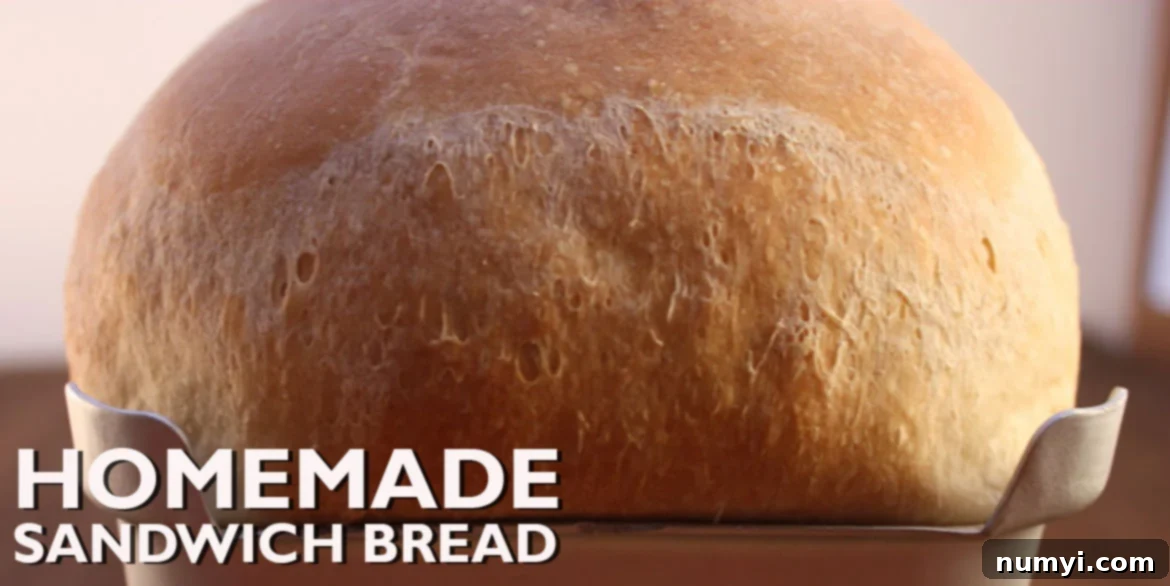Mastering Homemade Sandwich Bread: Your Easy Recipe for Perfectly Soft & Fluffy Loaves
For years, the quest for the ultimate homemade sandwich bread felt like an endless journey filled with culinary frustrations. I’ve spent countless hours in the kitchen, experimenting with a myriad of recipes, only to be met with disappointment. My relationship with bread baking was, to put it mildly, complicated. Every successful rise seemed to be followed by a texture I didn’t love or a flavor profile that missed the mark. The dream of a soft, airy, yet sturdy loaf, perfect for everyday sandwiches, often felt just out of reach.
But today, that long-standing challenge has finally been overcome. The search is over, and I’m thrilled to share a recipe that truly delivers.
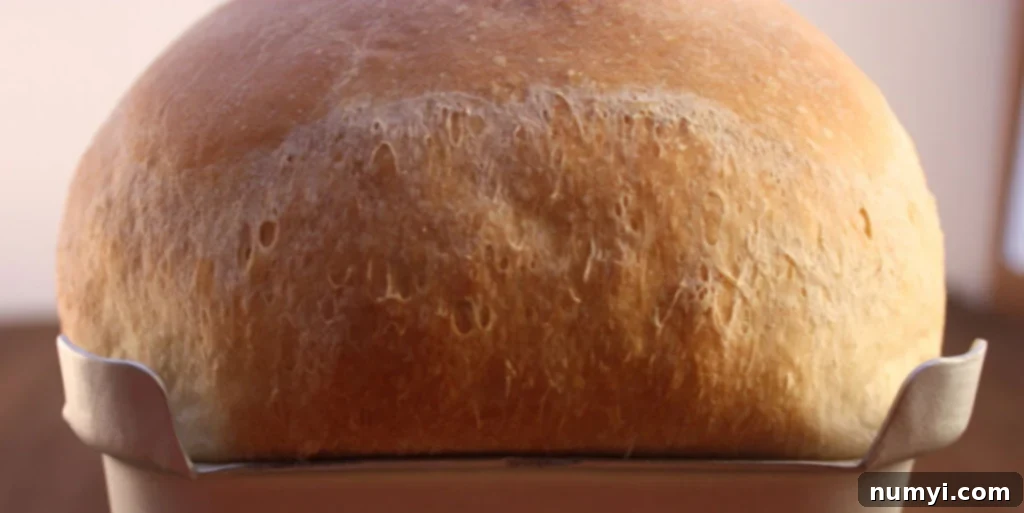
Don’t Sweat The Recipe is supported by its readers. We may earn a commission if you purchase through a link on our site. Learn more.
The culinary genius behind this incredible find is Delia at deliacreates. She has, without a doubt, become my favorite person. The moment I pulled this glorious loaf from my oven, golden and perfectly risen, I knew I had stumbled upon something truly special. This isn’t just a recipe; it’s a revelation for anyone who loves the comforting aroma and taste of freshly baked bread.
What makes this particular homemade sandwich bread recipe stand out even further is that it’s completely dairy and egg-free. This characteristic not only makes it suitable for various dietary needs but also contributes to its impressive shelf life. Most homemade breads tend to lose their freshness quickly, but this robust loaf lasted almost an entire week, maintaining its delightful texture and flavor. Imagine enjoying delicious, soft sandwich bread for days without worrying about it going stale!
Essential Ingredients for Your Perfect Homemade Sandwich Bread
Creating a truly exceptional loaf of bread starts with understanding the role of each ingredient. This recipe relies on a few simple components, each contributing to the bread’s incredible flavor and texture. Here’s a closer look at what you’ll need and why:
- Water – The foundation of any great bread. Warm water (ideally between 105-115°F or 40-46°C) is crucial as it activates the yeast, allowing it to “bloom” and create the necessary carbon dioxide for rising. Too hot, and it kills the yeast; too cold, and the yeast won’t activate.
- Sugar or Honey – These sweeteners do more than just add a hint of flavor. They are the primary food source for the yeast, fueling its activity and ensuring a robust rise. Additionally, sugar helps tenderize the dough, contributing to a softer crumb, and promotes beautiful browning of the crust. If using honey, a tip is to measure your oil first in the same measuring cup, then add the honey – it will slide right out without sticking!
- Oil – Vegetable oil, canola oil, or light olive oil works wonderfully here. Oil plays a vital role in tenderizing the bread, giving it that characteristic soft and supple texture. It also helps to keep the bread moist, significantly prolonging its shelf life by preventing it from drying out too quickly.
- Yeast – The magical leavening agent that brings life to your dough! You can use active dry yeast or instant yeast for this recipe. If you’re using active dry yeast, you’ll typically proof it first in warm water with a pinch of sugar. However, for instant yeast, you can often mix it directly with your dry ingredients, skipping the proofing step. This recipe uses a generous amount of yeast for a quick and impressive rise. Store your yeast in an airtight container in the refrigerator or freezer to maintain its potency.
- All-Purpose Flour – This versatile flour is perfect for achieving a wonderfully soft and tender sandwich bread. While all-purpose flour works perfectly, you could also opt for bread flour, which has a higher protein content. Using bread flour would result in a slightly chewier texture, offering a different but equally delicious experience. For a slightly healthier twist, consider substituting a portion (e.g., 1-2 cups) of the all-purpose flour with whole wheat flour, though this may require minor adjustments to liquid content and can result in a denser loaf.
- Salt – While not listed initially in the bullet points, salt is a critical component for flavor and structure. It enhances the taste of the bread and, importantly, regulates the yeast’s activity, preventing it from over-proofing. It also strengthens the gluten network, contributing to a better crumb structure.
Gathering these simple ingredients and understanding their functions will set you up for success in baking this fantastic homemade sandwich bread. You’ll be amazed at the quality you can achieve with such basic pantry staples.
Step-by-Step Guide to Baking Your Homemade Sandwich Bread
Ready to transform simple ingredients into a glorious loaf of bread? Follow these detailed steps to achieve the perfect soft and fluffy homemade sandwich bread that will impress everyone.
1. Activating the Yeast: The Unconventional Start
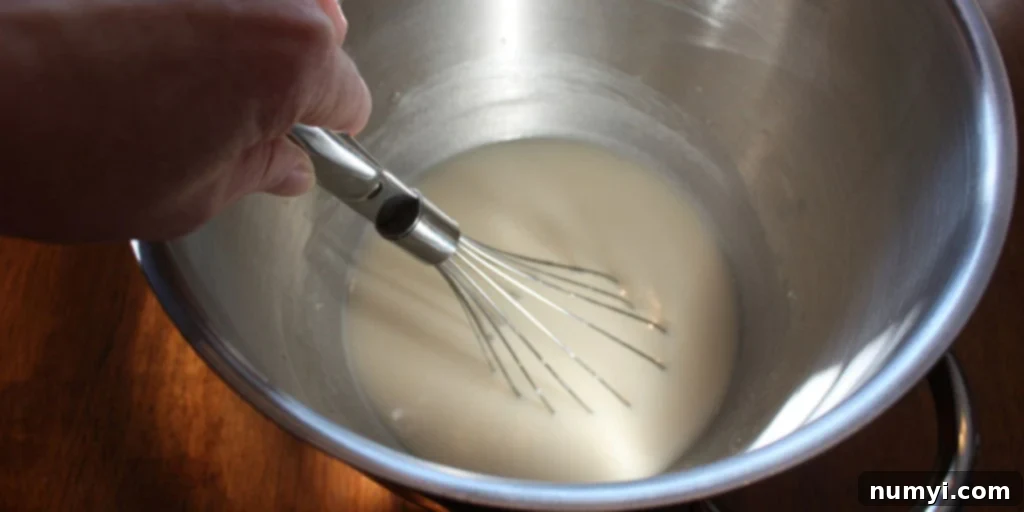
Unlike many traditional bread recipes that proof yeast with sugar, this particular method recommends adding salt directly to the yeast and hot water mixture. While it might seem unconventional, trust the process – it works beautifully! Ensure your water is adequately warm (as mentioned in the ingredients section) to gently awaken the yeast. You’ll know the yeast is active when it starts to bubble and foam, creating a frothy layer on the surface. This “blooming” indicates your yeast is alive and ready to make your bread rise.
2. Kneading the Dough: Building Structure and Softness

Kneading is the critical step where gluten develops, giving your bread its structure and elasticity. While you can certainly knead by hand, which offers a satisfying tactile experience and a good workout, a stand mixer with a dough hook makes the process effortless. I often set my mixer’s timer and use the opportunity to tidy up the kitchen while it works its magic. If you own a bread machine, you can use its dough cycle for an even more hands-off approach.
The recipe specifies a range of 5 to 7 cups of flour. This variability is common in bread baking, as humidity and flour type can affect absorption. The key is to add the flour gradually, one cup at a time, allowing the dough to come together. Stop adding flour as soon as the dough begins to pull away cleanly from the sides of the mixing bowl. Resist the temptation to add more flour than necessary, even if the dough feels a bit sticky. Over-flouring is a common pitfall that leads to dense, dry, and crumbly bread. The dough should be soft, pliable, and slightly tacky to the touch. A good test for readiness is the “windowpane test”: gently stretch a small piece of dough; if it stretches thin enough to be translucent without tearing, the gluten is well-developed.
3. The First Rise (Bulk Fermentation): Rapid Expansion!

A warm, draft-free environment is ideal for dough rising. My trick is to preheat my oven to its lowest setting (around 125 degrees Fahrenheit or 50 degrees Celsius) while I prepare the dough. Once it reaches temperature, I turn it off and simply switch on the oven light. The residual heat and gentle glow create the perfect cozy spot for fermentation.
Cover your mixing bowl with oiled plastic wrap – this prevents a dry skin from forming on the dough and makes for easier removal later. Allow the dough to rise for an impressively short 30 minutes, or until it has noticeably doubled in size. The generous amount of yeast in this recipe ensures a remarkably quick and vigorous rise. The transformation is truly astonishing.
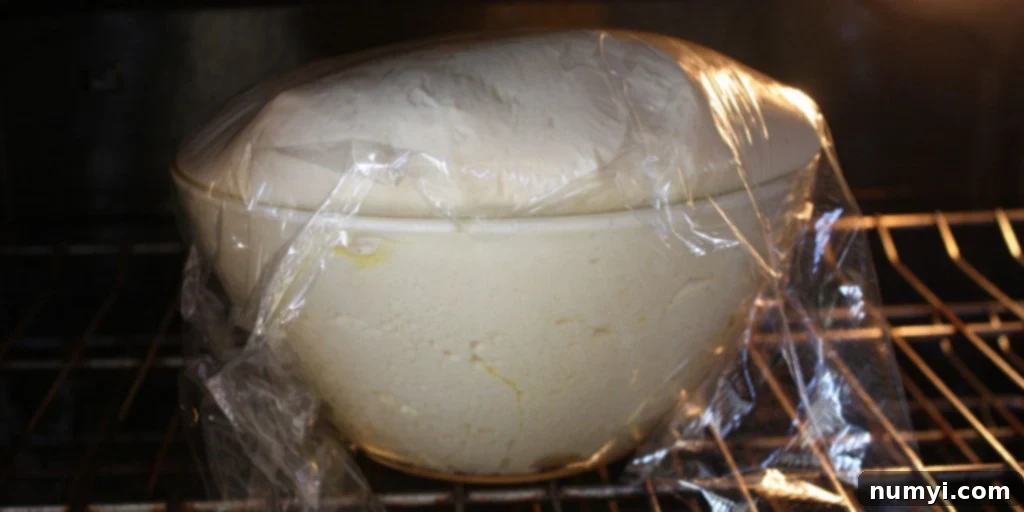
To truly appreciate the power of this recipe, I’ve included another photograph. You can clearly see just how much this dough expanded in merely 30 minutes! I was genuinely shocked by its rapid and substantial growth, which is a testament to the recipe’s effectiveness and the yeast’s vitality.

This dramatic rise signifies a healthy, active dough, ready for the next phase of its journey to becoming delicious homemade bread.
4. Shaping Your Loaves: From Dough to Pan
Once your dough has completed its first rise, it’s time to gently “punch down” the dough to release the accumulated gases. This process helps create a finer crumb structure. Turn the dough out onto a lightly oiled surface – using oil instead of flour at this stage helps maintain the dough’s moisture and prevents it from becoming dry. Grease your rolling pin as well. The dough for this recipe is wonderfully cooperative, making it easy to work with and shape.
This versatile recipe yields a substantial amount of dough, enough for two large loaves, three medium loaves, or even one gigantic loaf as featured here, alongside two mini loaves. You have the flexibility to choose the size that best fits your needs and loaf pans.
To shape a classic sandwich loaf, gently flatten the dough into a rectangle, roughly the width of your loaf pan. Then, starting from one of the longer sides, roll the dough tightly into a cylinder. Pinch the seam firmly along the bottom to seal it, and tuck the ends under to create a neat, compact loaf. This tight shaping helps create an even crumb and prevents large air pockets in your baked bread.
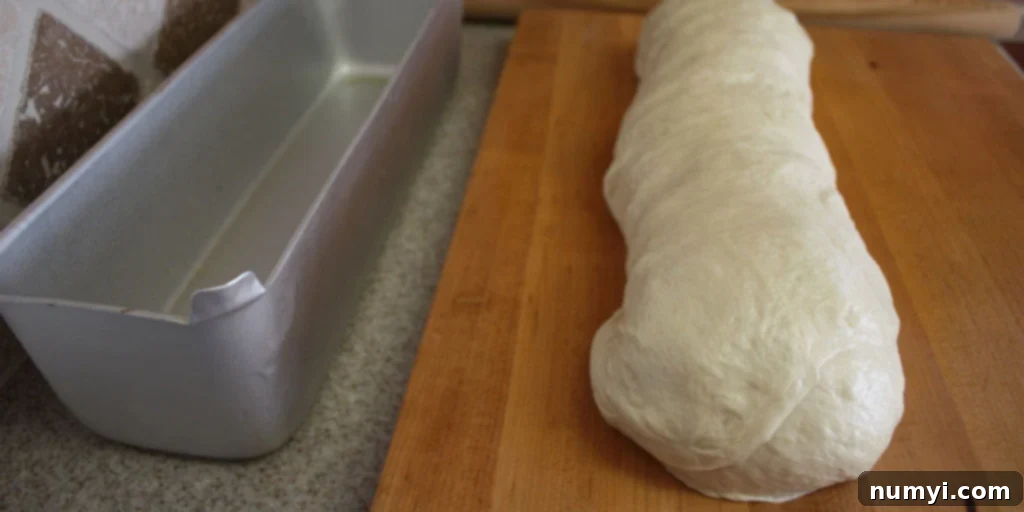
Place your perfectly shaped dough into a well-greased loaf pan. I was particularly excited to finally use my impressive 16″ bread loaf pan for this recipe; it measures 16 x 4 x 4 inches and is ideal for producing a truly substantial loaf. Ensure your pan is adequately greased to prevent sticking.
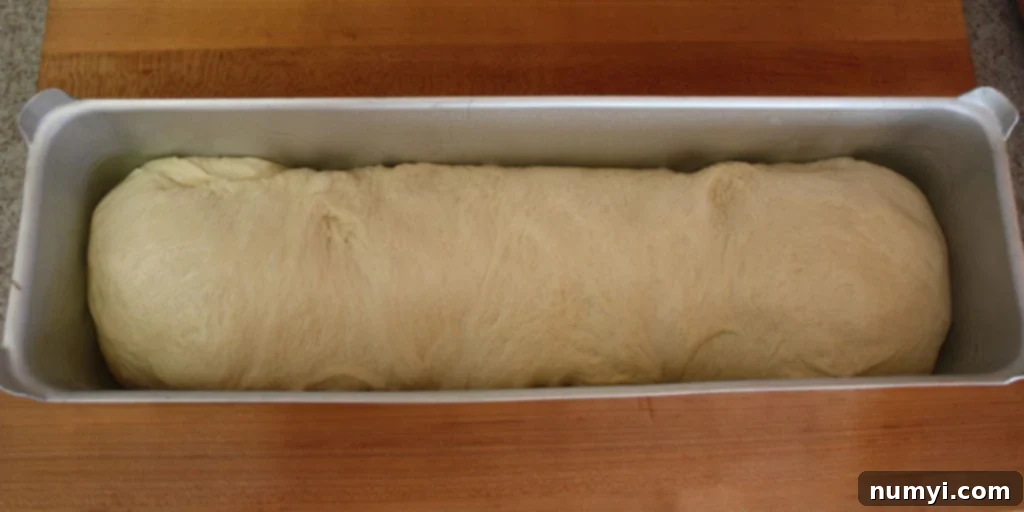
Once the dough is nestled in its pan, cover it again with greased plastic wrap. This is crucial to prevent the surface from drying out and forming a crust, which can inhibit the final rise. It’s now time for the second rise, also known as proofing.
5. The Second Rise (Proofing): Reaching for the Sky
Return the covered loaf pan to your slightly warm oven with the light on for another 30 minutes. This second rise allows the dough to relax and expand further, developing more air pockets that contribute to a light and fluffy texture. The dough should rise significantly, nearly doubling in the pan and proudly cresting over the rim. This impressive rise is a clear indicator of a well-proofed loaf, primed for baking.
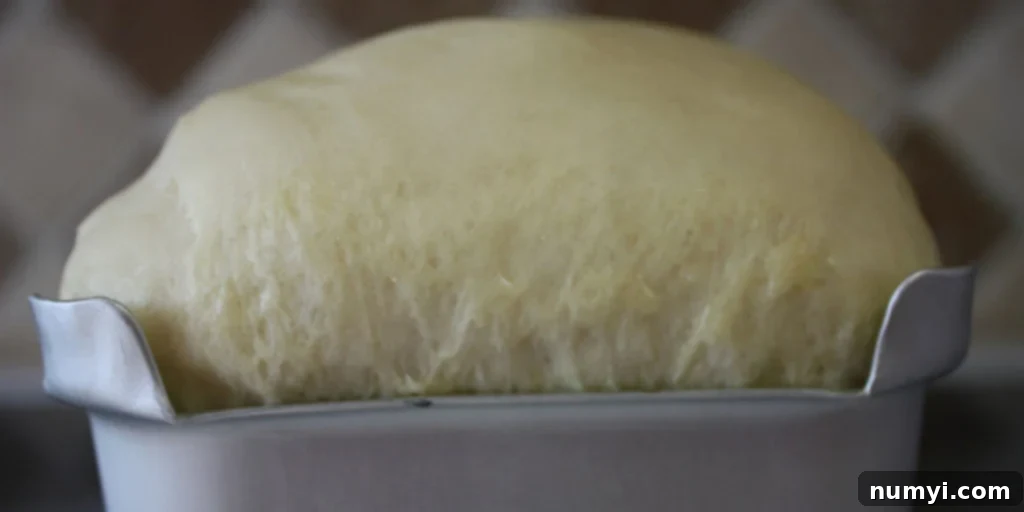
Just look at the incredible height this loaf achieves! The dough fills the pan beautifully and reaches impressive proportions, promising a truly substantial and satisfying bread.
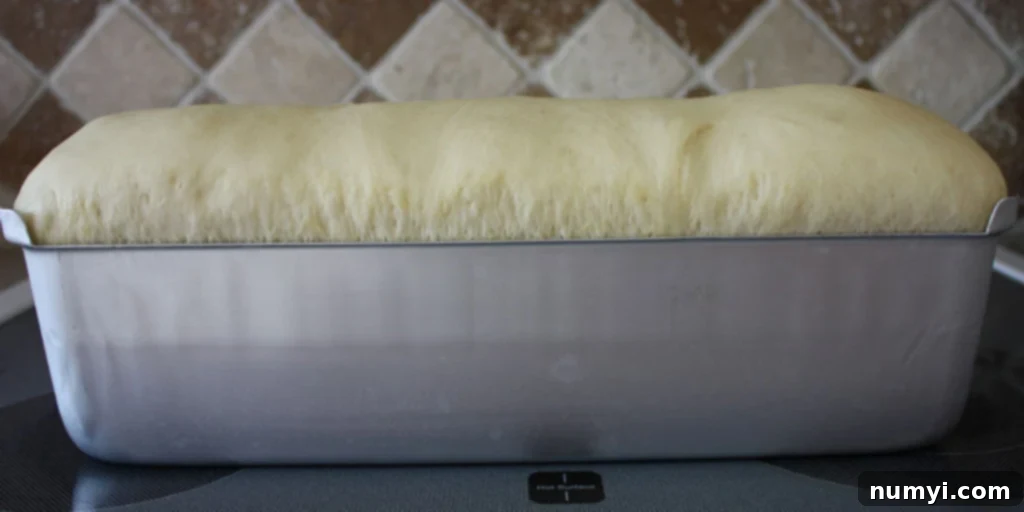
The image above captures the breathtaking full view of the homemade bread dough after its final, glorious 30-minute rise. It’s a sight to behold, a never-before-seen success in our home! With the dough perfectly proofed, it’s now ready for its transformation in the heat of the oven.
6. Baking to Golden Perfection
Remove the loaf pans from the warm oven before preheating it to the baking temperature. This is important because you want the bread to go into a hot oven to get a good oven spring and a crisp crust. Preheat your oven to 350 degrees Fahrenheit (175 degrees Celsius). Once the oven is hot, carefully place your risen loaves inside.
As this yeast bread bakes, your kitchen will be filled with the most intoxicating aroma – a comforting, warm scent that is one of the greatest joys of homemade baking. Bake the bread for approximately 30 minutes. You’ll know it’s done when the crust turns a beautiful golden brown, and when you gently tap the top of the loaf, it emits a hollow sound. This indicates that the interior is fully cooked and the moisture has evaporated sufficiently. For an even more precise measure, an internal temperature of around 200-210°F (93-99°C) confirms doneness.
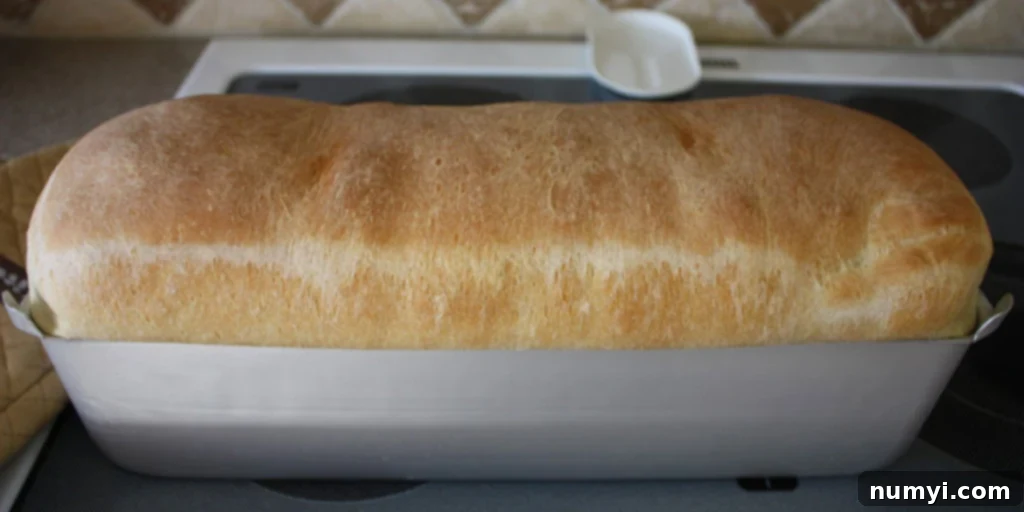
The ease and reliability of this recipe cannot be overstated. And truly, the size of this finished loaf is absolutely GINORMOUS! When I first sent a photo to my husband, he was somewhat unimpressed by a mere picture. But upon returning home from work and seeing this magnificent creation in person, he was genuinely astonished by its grandeur and perfection.
7. The Finishing Touch & Enjoyment

Once baked, allow the bread to cool in the pan for about 10 minutes before turning it out onto a wire rack to cool completely. While it’s still warm, rubbing the top crust with a stick of butter or brushing it with melted butter adds a beautiful, soft sheen and further enhances the flavor and crust texture. It’s a small step that makes a big difference.
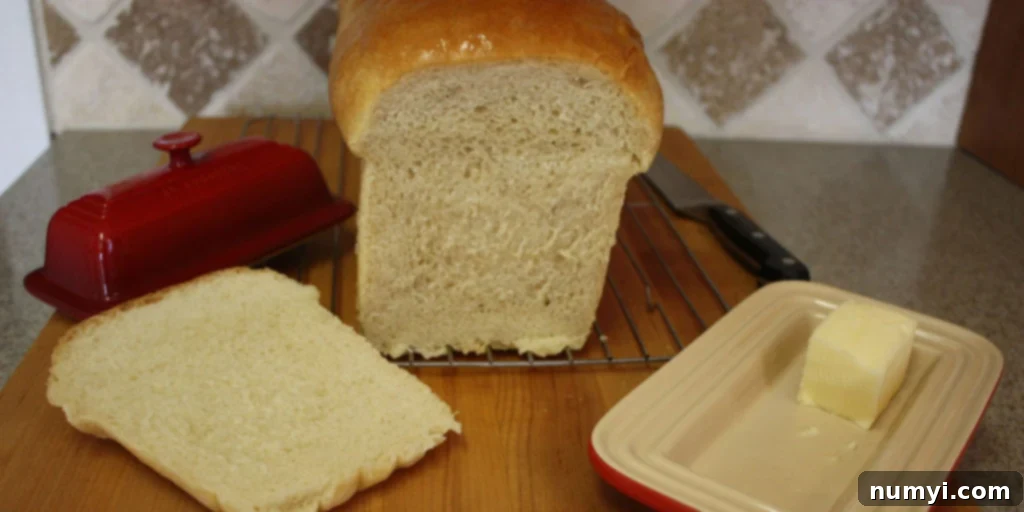
Though it’s tempting to slice into it immediately, letting your homemade bread cool completely is important for its internal structure and texture. However, we all know the allure of warm, fresh bread! Once cooled, slice and enjoy your delicious bread for days. This bread is incredibly versatile – perfect for all your sandwich needs, from simple PB&J to hearty deli creations. And let me tell you, toast made from this homemade bread is simply sensational, transforming your breakfast into a gourmet experience!
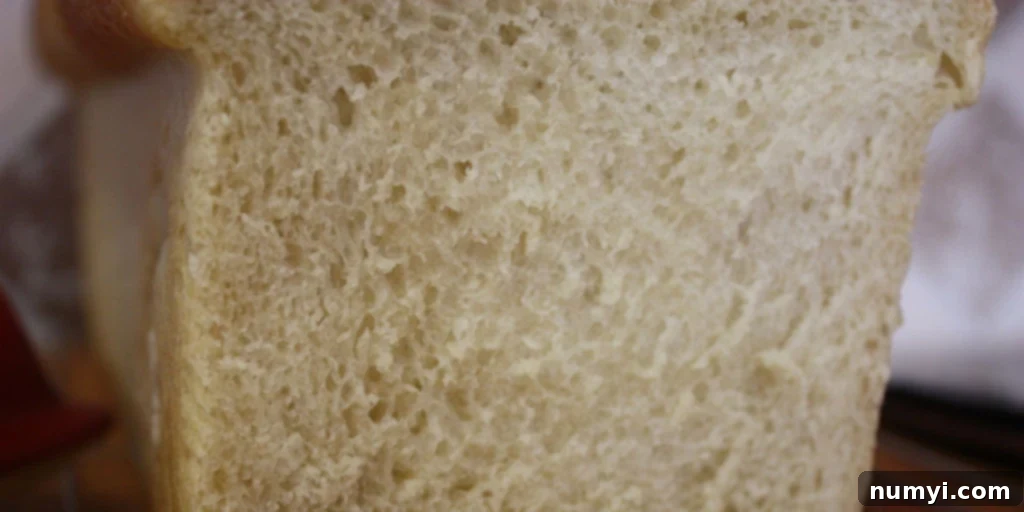
The even, soft crumb visible in the close-up confirms the success of this recipe. It’s the ideal texture for soaking up sandwich fillings or simply enjoying with a smear of butter.
Customizing Your Homemade Loaf
Don’t stop at just plain white sandwich bread! This base recipe is incredibly adaptable. You could experiment with a mix of whole wheat and white flour to create a wonderfully flavorful wheat bread. Feel free to explore other types of bread flour – perhaps a high-protein bread flour for a chewier loaf, or even a blend with some oat flour for a slightly nutty taste. Consider adding inclusions like sesame seeds, poppy seeds, dried herbs, or a sprinkle of grated cheese to the dough for a unique homemade touch.
Bread is more than just a food; it’s a timeless culinary art form, a staple that humanity has cherished for millennia. The possibilities it unlocks are endless – from wholesome sandwiches packed for lunch to delightful toast for breakfast, or simply as an accompaniment to a comforting meal. The satisfaction of slicing into a loaf you’ve baked yourself is unmatched.
While store-bought bread offers convenience, there’s no comparison in terms of taste, freshness, and the peace of mind that comes from knowing exactly what ingredients went into your food. This homemade bread loaf consistently delivers on flavor and texture. It has become our go-to whenever we’re crafting a truly “righteous” sandwich.
We absolutely encourage you to try baking a loaf of this fantastic homemade sandwich bread. If you whip up a batch, please share your experience with us. We’d love to hear how it turned out for you!
FAQs about Homemade Sandwich Bread
Yes, absolutely! Making your own bread is almost always significantly cheaper than buying it from the store, especially if you bake regularly. The core ingredients — flour, water, yeast, and oil — are relatively inexpensive, and you likely already have most of them stocked in your pantry. A large bag of flour, for example, can yield many loaves, bringing the cost per loaf down dramatically compared to even budget-friendly store brands.
In almost every way, yes. Homemade bread offers superior flavor, texture, and nutritional benefits. Store-bought bread often contains a lengthy list of ingredients, including artificial preservatives, high-fructose corn syrup, and dough conditioners, all designed to extend shelf life and simplify mass production. When you bake at home, you have complete control over the ingredients, allowing you to choose high-quality flour, natural sweeteners, and avoid unwanted additives, making your bread a healthier and tastier choice. The freshness and aroma alone are unparalleled.
Thanks to the oil in this recipe, this homemade sandwich bread stays fresh for an impressive amount of time. Stored properly, wrapped tightly at room temperature, it can last for about 5-7 days. For longer storage, you can freeze individual slices or whole loaves (see next FAQ).
Yes, freezing homemade bread is an excellent way to extend its shelf life. Once completely cooled, wrap the entire loaf tightly in plastic wrap, then again in aluminum foil, or place slices in an airtight freezer-safe bag. It will keep well in the freezer for up to 3 months. Thaw frozen slices in a toaster or at room temperature, and a whole loaf can be thawed overnight.
Several factors can affect bread rising. The most common issues are inactive yeast (check the expiration date and ensure proper storage) or water that’s too hot or cold during activation. Another factor can be a cold environment during the rising periods. Ensure your rising space is warm and draft-free. Over-kneading or under-kneading can also impact gluten development, which is crucial for a good rise. Don’t worry, practice makes perfect!
More Delicious Bread Recipes to Explore
If you’ve enjoyed the journey of making this soft and fluffy homemade sandwich bread, you might be ready to expand your baking repertoire. Here are a few more delightful bread recipes from our collection that are sure to please your palate and further enhance your skills in the kitchen:
Easy No Knead Overnight Focaccia Bread
Easy Homemade Crescent Rolls
Italian Bread Recipe
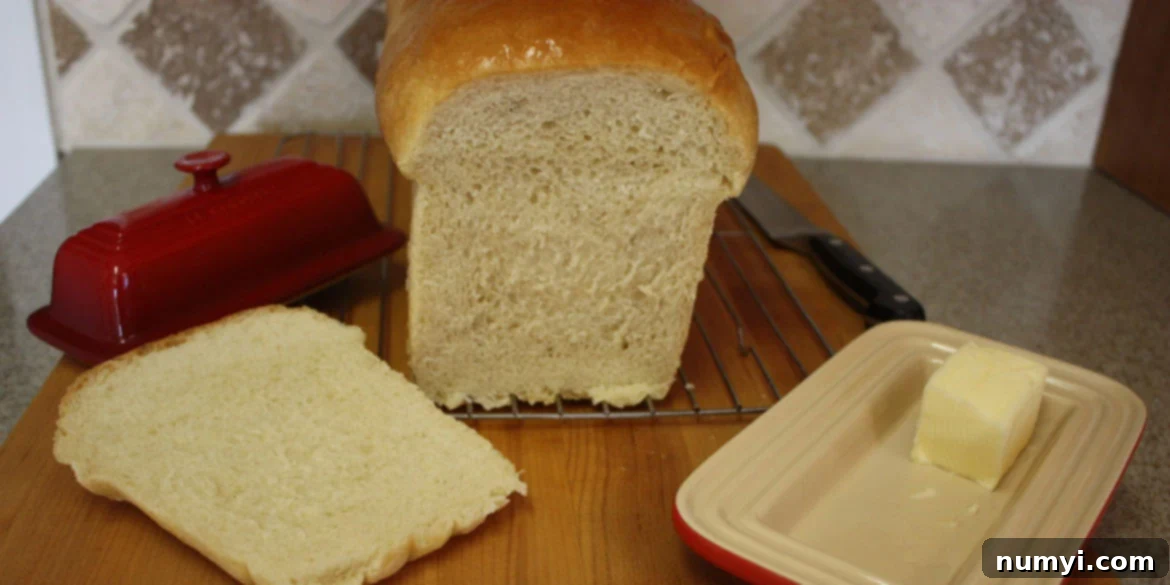
Homemade Sandwich Bread Recipe
Print
Pin
Rate
Ingredients
This recipe yields enough dough for 2 large loaves, 3 medium loaves, or 1 large loaf and 2 mini loaves. (The example photos feature one extra-large loaf).
- 2 1/2 cups HOT water {around 105-115°F or 40-46°C}
- 1/3 cup oil {vegetable, canola, or light olive oil}
- 1/3 cup sugar/honey {if using honey, fill the cup with oil first, empty it, and then fill it with honey so it doesn’t stick to the cup}
- 1 TBSP salt
- 3/4 cup all-purpose flour {for initial whisking}
- 5-7 cups all-purpose flour {divided, for kneading. The total flour used in the recipe will be 5.75-7.75 cups}
- 1 1/2 TBSP active dry or instant yeast
- Spray oil {for greasing bowls and surfaces}
Instructions
-
In the mixing bowl of your stand mixer, whisk together the hot water, oil, sugar or honey, and salt until well combined. Ensure the water is warm enough to activate the yeast but not so hot that it kills it (105-115°F is ideal).2 1/2 cups HOT water, 1/3 cup oil, 1/3 cup sugar/honey { fill the cup with oil first, 1 TBSP salt
-
Add 3/4 cup of the all-purpose flour to the wet mixture and whisk for 30 seconds. This creates a thin batter. Then, add the yeast and whisk for another 30 seconds. You should see the yeast starting to dissolve and become active, forming a frothy surface.3/4 cup flour and about 5-7 cups of flour, 1 1/2 TBSP yeast
-
Attach the dough hook to your stand mixer. Add an additional 2-3 cups of flour to the bowl and begin mixing on low speed until it’s just combined.
-
Continue adding the remaining flour, about one cup at a time, mixing thoroughly after each addition. Mix for approximately 5-7 minutes with the dough hook, or until the dough becomes smooth, elastic, and pulls away cleanly from the sides of the bowl. The dough should still be soft and slightly tacky, not dry.
-
The dough is properly kneaded when it’s smooth and elastic. To test, gently press two fingers into the dough; it should spring back quickly. If it slowly sinks or sags, it needs a bit more kneading to develop sufficient gluten.
-
Prepare for the first rise: Lightly grease a large, clean mixing bowl with spray oil. Transfer the kneaded dough to this bowl, turning it once to coat all sides with oil. Cover the bowl tightly with oiled plastic wrap to prevent a skin from forming.
-
For an ideal rising environment, preheat your oven to 125 degrees F (50 degrees C), then turn it off and switch on the oven light. Place the covered dough in the warm oven for about 30 minutes, or until it has doubled in size. This recipe’s quick rise is due to the generous yeast content.Spray oil
-
Once the dough has doubled, gently remove it from the oven. Preheat the oven again to 125 degrees F (50 degrees C), then turn it off and turn on the light to create a warm environment for the second rise.
-
Lightly grease your bread pans with spray oil. Gently punch down the dough to release the air, then turn it out onto a clean, lightly oiled countertop. Divide the dough into portions according to your desired loaf size (e.g., two large, three medium, or one extra-large as shown).
-
To shape each loaf, gently flatten the dough into a rectangle roughly the length of your loaf pan. Roll the dough tightly into a cylinder, starting from one of the longer sides. Pinch the seam firmly along the bottom to seal it, and tuck the ends neatly underneath to create a smooth, compact loaf. This shaping ensures an even rise and good crumb structure.
-
Place the shaped loaves into the prepared pans. Cover the pans with greased plastic wrap, ensuring the plastic doesn’t stick directly to the dough, to keep the dough from drying out during the second rise.
-
Place the covered loaves back into the warm oven (with the light on) for about 30 minutes, or until the dough has risen significantly to fill the pans and crest over the edges (almost doubled in size again). This second proof creates a light, airy texture. Once risen, remove the pans from the oven.
-
Preheat your oven to 350 degrees F (175 degrees C). Once heated, bake the bread for about 30 minutes. The bread is done when the crust is golden brown and, when tapped on the top, it sounds hollow. For a precise check, the internal temperature should be between 200-210°F (93-99°C).
-
Remove the bread from the oven and let it cool in the pans for about 10 minutes. Then, turn the loaves out onto a wire rack to cool completely. While still warm, you can optionally rub or brush the top of the loaves with butter to add shine and soften the crust.
Serving Suggestion:
-
As with all bread, it’s best to let it cool completely before slicing to ensure the best texture and structure. However, if you can’t resist the allure of warm, fresh bread, a slightly warm slice is also a treat! Enjoy your homemade bread with your favorite fillings, as toast, or alongside a meal.
Notes
Flour measurement: The total flour added during the kneading process should amount to about 5-7 cups. This range does NOT include the 3/4 cup of flour used in step 2. The exact amount can vary based on humidity and your specific flour.
Storage: Store your cooled homemade sandwich bread in an airtight container or bread bag at room temperature for up to 5-7 days. For longer storage, slices or whole loaves can be frozen for up to 3 months.
